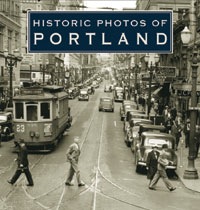As I mentioned before, I find myself the owner of a book entitled Historic Photos of Portland. I guess they have a whole series with various cities in the US. I’ve been meaning to pour through it for the past few weeks, but between busy weeks and busy weekends, I never had the time. The one time I did have a few moments, I couldn’t find it! (Kim had carried it away to read for herself!)
First, I was a little surprised when I entered it into my bookkeeping system (yes, I catalog all of my books) and found it sat alongside another book I own from the very same author! I had picked up Progressive Portland – On The Move from Powell’s years ago, read through it, then forgot I owned it. The layout is very similar to the Then and Now post I made last month. It was probably subconsciously inspired by the book’s format. This new book skips the then-and-now format and shows full-page pictures of how Portland used to look
At any rate, it looks like this author (Donald R. Nelson) scours the various archives around Portland for old photos and makes amazing picture books from them. Historic Photos of Portland is no exception.
The book is split into chapters by time period:
- Pre-Civil War to the End of the Nineteenth Century (1860-1899)
- The City at the Turn of the Century (1900-1919)
- A Developing Metropolis (1920-1939)
- From 1940 to a Modern City (1940-1970s)
I definitely have to say that the more visually interesting chapters are the first–the furthest back in time. For the most part, though, they are also the most “detached.” The photos seem like they could have been taken anywhere because there are few landmarks (natural or man-made) that anchor the pictures to something known in the modern world us Portlanders live in. The more modern photos have recognizable locations, but also a more mundane quality to them–mainly because the objects, architecture, and clothing are not terribly foreign. We’ve all seen classic 50s cars and land-boat 70s gas guzzlers. Asphalt roads and concrete buildings are pretty standard.
Anyway, starting with the eldest photos, the city really isn’t recognizable as any sort of metropolis. It pretty much consisted of what’s now downtown, but the layout was mostly Victorian mansions on city-block-sized yards. We have a rather green downtown today, as far as cities go, but back then, it was almost nothing but green! There were dirt streets, horse-drawn carriages, well-dressed men (very few pictures of women aside from a shopkeeper or two–I guess they were all at home doing womanly things), and even a (Steel) bridge! I didn’t realize it, but Skidmore fountain was built in 1888! The first of many documented floods was in 1894–the water level went about half-way up the ground floor of buildings.
The early 1900s brought more people and more commerce. There’s a great photo of the streetcar in 1904 that’s similar to one I’ve seen elsewhere (perhaps a historic photo on the bus or streetcar?) Typically, when I think of streetcars, I think of busy streets, tall buildings, and people around. In these photos, it’s just a streetcar on a pair of rails that stretch off toward the horizon. There are miles of fields without a single building in sight. The only visible human is the streetcar operator. That seems to me like a very lonely streetcar. This era brings more ships and a few cobblestone roads.
In the roaring 20s and great depression, the city becomes a bit more recognizable. There’s a great picture of “the brand new Burnside bridge!” I used to walk that all the time and it looks the same then as it does now (well, “now” being about a year ago–it’s been under construction/repair for a while.) There’s a photo of the St. John’s bridge as it’s under construction. The suspension cables are all there, dangling down, but they are not attached to any sort of deck or road. It’s kind of freaky looking!
The 40s through 70s is pretty much what you would expect it to be. I’d really like to say something extra about it, but none of the photos struck me as anything worthy of special mention.
Overall, it’s a really nifty book. I’ve been craving information about the history of Portland recently and this satisfies a good chunk of that. I have to say that I was a tiny bit disappointed that it was primarily a picture book–the text in it amounted to captions and a few paragraphs starting each chapter–but I think that whole internet thing of not being able to browse it first caused me to set my expectations a little incorrectly. To further my knowledge of Portland history, I think that next time I’m at Powell’s I will see if I can find something with a little more text and stories. Regardless, the pictures are a great taste and are easy to quickly show off to friends and family. It’s a great book and will have a heartfelt home on our coffee table!
